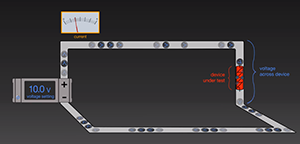Part of the Lake Shore Academy video education series, a new video demonstrates the theoretical operation of a DC current and voltage source as well as some notable implications during practical application.
 There are many representations of circuits that describe voltage, current, and resistance, though trying to explain the fundamental characteristics of electricity in a visual way can be difficult. Often, in descriptions of electricity, we are given the fluid analogy where voltage is represented by the fluid pressure, current is represented by the flow, and resistance is represented by constriction of the conduit. This is an effective conceptualization of electricity, though it lacks in its ability to describe electricity visually. Without flow meters and pressure meters, the fluid analogy doesn’t help to describe what is happening in an electrical circuit in a visual manner.
There are many representations of circuits that describe voltage, current, and resistance, though trying to explain the fundamental characteristics of electricity in a visual way can be difficult. Often, in descriptions of electricity, we are given the fluid analogy where voltage is represented by the fluid pressure, current is represented by the flow, and resistance is represented by constriction of the conduit. This is an effective conceptualization of electricity, though it lacks in its ability to describe electricity visually. Without flow meters and pressure meters, the fluid analogy doesn’t help to describe what is happening in an electrical circuit in a visual manner.
This series of animations shows a simple experiment with a DC source and device being tested, where voltage is represented by the height of the circuit and current is represented by the speed of the particles travelling within the circuit. This visual representation of Ohm’s Law (V=IR) in three dimensions attempts to make the concept of electrical phenomena more easily understood. Voltage, as potential, is depicted as height. The resulting voltage drop from a resistor is depicted as a figurative drop from this height. All visual depictions of electricity will fail to describe what is occurring with complete accuracy, though hopefully this method succeeds in explaining the concepts where some have failed.
Stay tuned for the next video in the series demonstrating an AC current and voltage source.
